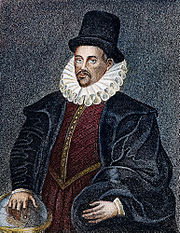
William Gilbert (astronomer)
About this schools Wikipedia selection
SOS Children offer a complete download of this selection for schools for use on schools intranets. SOS Child sponsorship is cool!
| William Gilbert | |
|---|---|
 Dr William Gilbert |
|
| Born | May 24, 1544 Colchester |
| Died | November 30, 1603 London |
| Occupation | physician, natural philosopher |
William Gilbert, also known as Gilbard ( Colchester, England, May 24, 1544 – London, England, November 30, 1603) was an English physician and a natural philosopher. He was an early Copernican, and passionately rejected both the prevailing Aristotelian philosophy and the Scholastic method of university teaching. After gaining his MD from Cambridge in 1569, and a short spell as bursar of St John's College, Cambridge, he left for practice in London and in 1600 was elected President of the College of Physicians (not by that point granted a royal charter). From 1601 until his death in 1603, he was Elizabeth I's own physician, and James VI and I renewed his appointment.
Scientifically, Gilbert is known for his investigations of magnetism and electricity. Gilbert is credited as one of the originators of the term electricity, and many regard him as the father of electrical engineering or father of electricity and magnetism.
His primary work was De Magnete, Magneticisque Corporibus, et de Magno Magnete Tellure (On the Magnet and Magnetic Bodies, and on the Great Magnet the Earth) published in 1600. In this work he describes many of his experiments with his model earth called the terrella. From his experiments, he concluded that the Earth was itself magnetic and that this was the reason compasses pointed north (previously, some believed that it was the pole star ( Polaris) or a large magnetic island on the north pole that attracted the compass). He was the first to argue, correctly, that the centre of the Earth was iron, and he considered an important, and related, property of magnets is that they can be cut, each forming a new magnet with north and south poles. So the earth being one giant magnet posed no problems.
The English word electricity was first used in 1646 by Sir Thomas Browne, derived from Gilbert's 1600 New Latin electricus, meaning "like amber". The term was in use since the 1200s, but Gilbert was the first to use it to mean "like amber in its attractive properties". He recognized that friction with these objects removed a so-called effluvium, which would cause the attraction effect in returning to the object, though he did not realize that this substance (electric charge) was universal to all materials.
The electric effluvia differ much from air, and as air is the earth's effluvium, so electric bodies have their own distinctive effluvia; and each peculiar effluvium has its own individual power of leading to union, its own movement to its origin, to its fount, and to the body emitting the effluvium.— De Magnete, English translation by Paul Fleury Mottelay, 1893
In his book, he also studied static electricity using amber; amber is called elektron in Greek, so Gilbert decided to call its effect the electric force. He invented the first electrical measuring instrument, the electroscope, in the form of a pivoted needle he called the versorium.
Like others of his day, he believed that "crystal" (quartz) was an especially hard form of water, formed from compressed ice:
Lucid gems are made of water; just as Crystal, which has been concreted from clear water, not always by a very great cold, as some used to judge, and by very hard frost, but sometimes by a less severe one, the nature of the soil fashioning it, the humour or juices being shut up in definite cavities, in the way in which spars are produced in mines.— De Magnete, English translation by Silvanus Phillips Thompson, 1900
Gilbert argued that electricity and magnetism were not the same thing. For evidence, he (incorrectly) pointed out that, while electrical attraction disappeared with heat, magnetic attraction did not (although it is proven that magnetism does in fact become damaged and weakened with heat). It took James Clerk Maxwell to show that both effects were aspects of a single force: electromagnetism. Even then, Maxwell simply surmised this in his A Treatise on Electricity and Magnetism after much analysis. By keeping clarity, Gilbert's strong distinction advanced science for nearly 250 years.
Gilbert's magnetism was the invisible force that many other natural philosophers, such as Kepler, seized upon, incorrectly, as governing the motions that they observed. While not attributing magnetism to attraction among the stars, Gilbert pointed out the motion of the skies were due to earth's rotation, and not the rotation of the spheres, 20 years before Galileo (see external reference below).
A unit of magnetomotive force, also known as magnetic potential, was named the gilbert in his honour.
Gilbert died on November 30, 1603. His cause of death is thought to have been the bubonic plague.
Whilst today he is generally referred to as William Gilbert, he also went under the name of William Gilberd. The latter was used in his and his father's epitaph, the records of the town of Colchester, the Biographical Memoir in De Magnete, and the name of The Gilberd School in Colchester, named after Gilbert.

